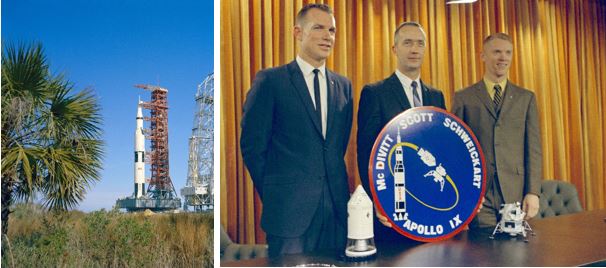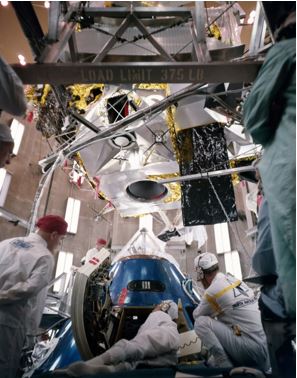Apollo 8 had returned from its historic first lunar orbit mission just a week before. Damage to Launch Pad 39A was minimal from the Dec. 21, 1968, launch of Apollo 8, allowing workers to refurbish it in time for the Jan. 3, 1969, rollout of the Saturn V vehicle for the Apollo 9 mission. Stages of the rocket had been arriving at KSC during the spring and summer of 1968, the Lunar Module (LM) arrived in June and the Command and Service Modules (CSM) in October. Stacking of the Saturn V was completed in October, with the Apollo spacecraft added in early December.
Apollo 9 astronauts Commander James A. McDivitt, Command Module Pilot (CMP) David R. Scott, and Lunar Module Pilot (LMP) Russell L. Schweickart were in training for their upcoming flight which would be notable in its own way. At the time planned for late February 1969, Apollo 9 was the first crewed mission to test the all-important LM, the vehicle that took two astronauts down to the Moon’s surface and returned them to the waiting Command Module (CM) in lunar orbit. On its first uncrewed test flight, Apollo 5 in January 1968, the LM had performed so well that NASA deemed a second unpiloted test flight unnecessary. During Apollo 9, in the relative safety of Earth orbit, McDivitt and Schweickart planned to enter the LM, undock from Scott who would remain in the CM, and fly the LM up to 100 miles away, testing the systems of its descent and ascent stages before performing a rendezvous and docking with the CM and reuniting with Scott.
In an additional task, Schweickart and Scott would each perform a spacewalk or extravehicular activity (EVA) from their respective spacecraft. Scott would only stand in the open CM hatch while Schweickart would exit via the LM’s front hatch onto its porch, translate over to Scott using handrails, retrieve materials samples mounted on the spacecraft’s exterior and return back to the LM. This would test the capability of crews to transfer through open space, in case a malfunction with the transfer tunnel or hatches between the two spacecraft prevented an internal transfer. This was the only spacewalk experience and in-orbit vacuum test of the space suit before the Moon landing.
International Latex Corporation (ILC) of Dover, Delaware, developed two versions of the Apollo A7L space suit for NASA – one for intravehicular activity (IVA) and one for extravehicular activity (EVA) which included the Portable Life Support System (PLSS) backpack. Both types of the suit could operate under vacuum conditions, but the crewmember wearing an IVA version remained attached to the spacecraft via hoses that provided life support such as oxygen. The EVA version’s PLSS provided the required oxygen during spacewalks away from the vehicle, as would be required on the lunar surface. For Apollo 9, McDivitt and Schweickart wore the EVA version (even though McDivitt was not scheduled for an EVA) while Scott wore the IVA.
The prime crewmembers, as well as their backups Commander Charles “Pete” Conrad, CMP Richard F. Gordon, and LMP Alan L. Bean trained for the EVAs. In October, during zero-g parabolic flights aboard a KC-135 aircraft, prime and backup CMPs Scott and Gordon and LMPs Schweickart and Bean practiced egressing and ingressing a mockup CM while wearing space suits. In December, Schweickart and Bean tested their A7L EVA space suits with the PLSS under vacuum conditions in Chamber A of the Space Environment Simulation Laboratory (SESL) at the Manned Spacecraft Center, now the Johnson Space Center in Houston. Scott also tested his IVA suit in the SESL.
For more insight into the Apollo 9 EVA, read Schweickart’s oral history with the JSC History Office.




























